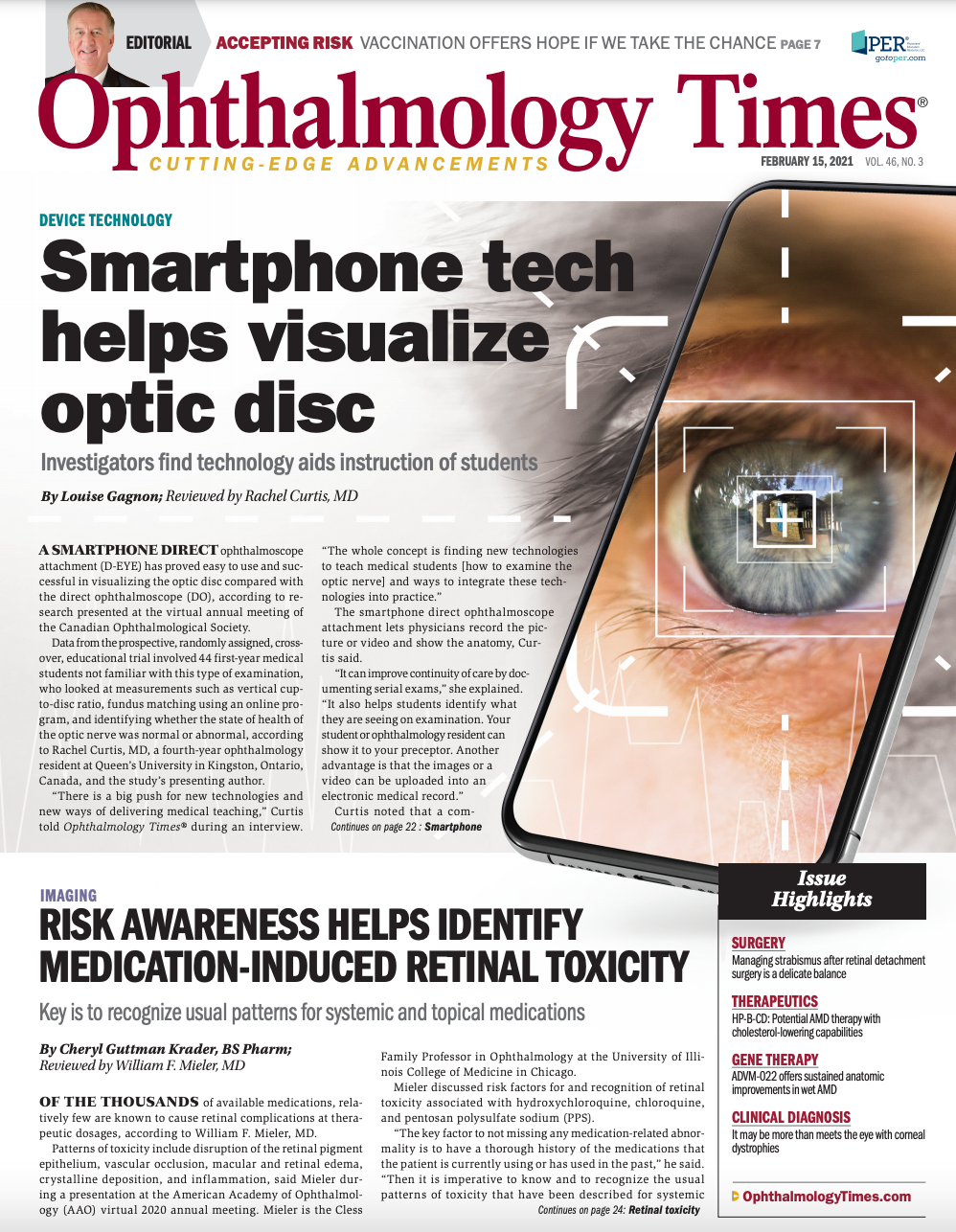Publication
Article
Digital Edition
IOLs offer great vision, low risk profile for myopia
Author(s):
Phakic option provides hope to patients who are not candidates for laser vision correction.
Images A, B, and C show the implantation of the ICL. (Images courtesy of Gregory D. Parkhurst, MD, FACS)


This article was reviewed by Gregory D. Parkhurst, MD, FACS
Myopia is a recognized global epidemic expected to affect almost half of the world’s population by 2050.
High myopia is also increasing in the United States and Canada and is projected to affect an estimated 260 million individuals, representing a fivefold increase in the 2 countries.
Related: Iris-fixated IOLs are a boon for treating high myopia
The currently widely used methods of myopia treatment and myopia correction—glasses, contacts, or laser vision correction—are not ideal for treating every person with myopia because of thin or abnormal corneas, contact lens intolerance, or anisometropia, according to Gregory D. Parkhurst, MD, FACS, the CEO of Parkhurst NuVision in San Antonio, Texas.
Patients who are not candidates for laser vision correction may be the ones who can benefit most from implantation of a phakic intraocular lens (IOL).
Parkhurst and colleagues conducted a retrospective study1 of phakic IOL implantation in military personnel who received the Visian Implantable Collamer Lens (ICL) (STAAR Surgical), and in whom laser vision correction was not ideal because of abnormal topography, thin predicted residual bed, and/or dry eye disease.

In these patients, refractive predictability within 0.5 diopter with the ICL was seen in 90% of eyes and 96% achieved 20/20 uncorrected vision, he reported.
The objective results are good in a population with abnormal corneas, so the obvious next question is whether this technology should be limited to individuals who are not considered candidates for laser vision correction.
One study2 supported the idea that phakic IOLs provide the best quality-of-life scores compared with other refractive surgeries such as laser vision correction.
Related: Extended depth-of-field IOLs: Clarifying current nomenclature
In addition, Parkhurst reported results that showed night vision was superior in patients with phakic IOLs compared with those who underwent wavefront-optimized LASIK even for moderate levels of myopia.3
One advantage associated with phakic IOLs is a relatively small learning curve to overcome for experienced anterior segment lens surgeons, and the fact that the surgical technology is less expensive to access than laser equipment that can cost several hundred thousand dollars to acquire.
All a surgeon really needs is an operating microscope, a basic cataract set, and a few special forceps to get started.
In addition, the postoperative care is very similar to that associated with cataract and refractive lens surgery with the important addition of monitoring the vault of the phakic IOL, Parkhurst pointed out.
Related: Aspheric, aberration-free IOL leverages technology for performance
As with any surgical procedure (or nonsurgical treatment of myopia), there are risks associated with phakic IOL implantation.
Endophthalmitis is associated with performance of any intraocular procedure, and the rate associated with phakic IOL implantation is 0.017% (1 in 6,000 cases).
Postoperative intraocular pressure (IOP) spikes that require intervention occur in 3.2%, and the risk of pupillary block after implantation of the ICL is 0.7%, Parkhurst noted.
Development of cataracts is another risk associated with implantation of phakic IOLs. Seven reports of 3 to 7 years of follow-up after phakic IOL implantation noted clinically relevant cataracts with incidence rates of less than 2%; 1 report cited a much higher risk of cataracts in patients with very high myopia and older age.
Related: Small-aperture single-piece IOL could fill unmet need in patients
In contrast, endothelial cell loss over time has not been a clinically significant problem with the ICL.
Future of ICLs
The future of phakic IOLs may include further improvements in safety resulting from better ways to size the ICL, Parkhurst said, as well as minor design modifications, diagnostics, and improvements in the sizing nomograms.
“The sulcus distance is highly variable in eyes; accommodation plays a role as do the shape and anterior lens rise of the human crystalline lens,” he said.
Related: Analyzing the visual, non-visual benefits of VLF IOLs
Future developments in the ICL platform include the availability of presbyopia-correcting models.
In addition, development of a lens with a central fenestration used in Europe resulted in fewer IOP spikes and no cataract development, possibly due to increased flow of aqueous over the anterior lens epithelial cells.
An important consideration for Parkhurst, considering the good safety profile of the Visian ICL and the demand for refractive surgery, is use of a phakic IOL to preserve the cornea and lens for the future.
When the cornea is borderline, he explained, the question that must be asked by surgeons is whether they would rather implant a phakic IOL and leave open all options for presbyopia and cataract correction, or potentially risk the integrity of the cornea with the associated risk of corneal transplantation or need for cross-linking. He often opts to implant a phakic IOL.
“As surgeons we must help our patients balance the risks, benefits, and alternatives of all options to treat myopia,” Parkhurst concluded. “Modern phakic IOLs offer high-quality vision, a low-risk profile, and preserve the cornea and lens for the future and can be an important tool for the comprehensive refractive surgeon.”
--
Gregory D. Parkhurst, MD, FACS
e:gparkhurst@parkhurstnuvision.com
Parkhurst is a consultant to STAAR Surgical.
References
1. Parkhurst GD, Psolka M, Kezirian GM. Phakic intraocular lens implantation in United States military warfighters: a retrospective analysis of early clinical outcomes of the Visian ICL. J Refract Surg. 2011;27(7):473-481. doi:10.3928/1081597X-20110106-03
2. Leong A, Hau SCH, Rubin GS, Allan, BDS. Quality of life in high myopia before and after implantable Collamer lens implantation. . 2010;117(12):2295-2300. doi:10.1016/j.ophtha.2010.03.055
3. Parkhurst GD. A prospective comparison of phakic collamer lenses and wavefront optimized laser-assisted in situ keratomileusis for correction of myopia. Clin Ophthalmol. 2016;10:1209-1215. doi: 10.2147/OPTH.S106120

Newsletter
Don’t miss out—get Ophthalmology Times updates on the latest clinical advancements and expert interviews, straight to your inbox.




